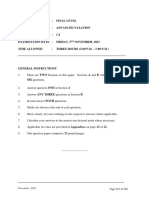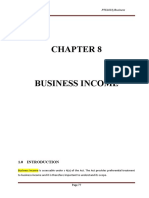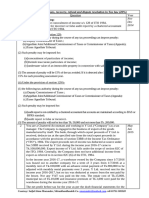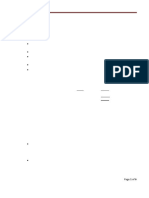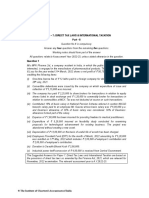Download
Download
Uploaded by
John KitwikaCopyright:
Available Formats
Download
Download
Uploaded by
John KitwikaOriginal Title
Copyright
Available Formats
Share this document
Did you find this document useful?
Is this content inappropriate?
Copyright:
Available Formats
Download
Download
Uploaded by
John KitwikaCopyright:
Available Formats
SUGGESTED ANSWERS
C4 – ADVANCED TAXATION
NOVEMBER 2021
ANSWER 1:
(a) Name of Tax Payers: Elishadai, Elihumbiza and Elizanidho (3Es Partnership)
Nature of Income: Business Income
Type of Business income: Manufacturing Furniture and leasing of Assets.
Residential Status” Resident Person.
Year of Income: 2020 **
TZS.”000” TZS “000”
Profit as per accounts 356,000*
Add back: Non-allowable deductions
Partners salaries (30+25+20) million 75,000*
Brokerage fee to partners (10+5+14) 29,000*
million
Interest on Equity Capital (10+15+21) 46,000*
million
Interest on Debt Capital (15+25) million 40,000*
Utilities – structural alterations (capital 35,000*
nature)
Reserve for Gratuity 124,000*
Bad debts reserve 112,000*
Income Tax 125,000*
Machinery Lease 70,000* 656,000
Less: Allowable deductions
Excise duty (10,000)*
Adjusted partnership business income 1,002,000*
(b) Tax treatment/effects
• The dividends of K Ltd from subsidiary companies owning more than 25% are
taxable in the form of final withholding tax by virtue of section 54(2) of ITA Cap332
(Section 54(2) applies to resident entities only. The assumption is that all entities
are resident entities.
• The K Ltd is no longer a parent company to M Ltd as it may control or benefit less
than 50% by virtue of section 3© or ITA Cap 332.
• There is a change in control in the L Ltd where K Ltd will no longer be a parent
company and the assets owned and liabilities owed will be treated as being realized
by a subsidiary company U Ltd by virtue of section 56(1) of TA Cap 332.
• All items which affect tax will not carried forward or back virtue of section 56(2)
of ITA Cap 332.
• The subsidiary companies have to prepare two sets of accounts as the period before
and after change of ownership are to be treated as separate years of income, one set
from March to June 2021.
November, 2021 Page 374 of 384
(c) VAT as applied in insurance contract
Insurance brokers and agents account for value added tax in a normal way as traders
does and others. However, taxable supplies provided by the insurer has slight difference
from other businesses.
• An insurer accounts for VAT on net premium amount received in relation with a
contract of insurance. Further, Value Added Tax (General) Regulation defines
net premium amount received as the total premium received in any given ta period
less payment made for settlement of any claim arising from a contract of insurance
and amounts of premium paid for that period to other insurers for the purpose of
reinsurance. Therefore, the VAT tax payable or liability of an insurer or insurance
brokers depends on the net premiums amount they make.
• Similarly, where an insurer subsequent recovers from an insured person part of
the claim paid in relation to a contract of insurance, whether through fraudulent
claim or claim from a third party under the principle of subrogation, the insurer is
required to make an increasing adjustment.
• According to regulation 35(3) of the Value Added tax (General) Regulation 2015,
when a taxable insured receives payment in respect of settlement of claims under
the contract of insurance should account for output tax on that amount but the
same insured person cannot claim input tax credit in relation to a purchase of the
contract of insurance.
• On the same manner, when an insurer makes payments in respect of a claim under
the contract of insurance to an insured person is eligible for input tax credit for the
claim irrespective of whether it has been paid to on-taxable person. It also
important to note that, the insurer is not eligible to claim input tax credit in relation
to a cost of sales, administration and management relating to supply of under the
contract of insurance insurers.
• Lastly as per regulation 35(7) of the Value Added tax (General) Regulation 2015,
the supply of salvage by an insurer attracts value added tax and the term salvage
has been defined as damaged property an insurer takes over to reduce its loss after
paying a claim.
• Treatment of output ta and input tax is also differentiated between Life
Insurance and General Insurance
• To conclude on VAT on insurance business, it can be stated that apart from the
matters mentioned above, other transactions receives same tax implications and
treatments on same manner as to other businesses.
(d) VAT – Dingu suppliers
(i) Computation of Output tax
Amount Output tax (18/118) Exempt
Sales at standard rate 28,420,000 4,335,254
Exempt supplies 7,000,000 - 7,000,000
Exports to Congo 10,000,000 0
45,420,000 4,335,254 7,000,000
November, 2021 Page 375 of 384
(ii) Computation of Input tax
Input tax relating to purchases of taxable supplies
VALUES INCLUSIVE VAT input
OF TAX IN TZS. (18/118)
IN TZS
Purchases at standard rate 12,180,000 1,857,966
Imported goods 21,806,400 3,326,400
Total input tax (B) 5,184,366
I: Input tax relating to purchases of both taxable and exempt supplies
VALUES INC VAT TZS VAT
Audit fees 1,044,000 159,254.24
Purchases of printing materials 725,000 110,593.22
Catering for firm employees 2,030,000 309,661.02
Telephone expenses 1,450,000 221,186.44
Payment of water bill 525,000 80,084.75
5,774,000
VAT input 800,780 800,780
(5,774,000*18/118)
Test for T/A 85% 85%
Input tax liability for Partial 680,663 680,663
supplies
Test for T/A
Taxable supplies = (TZS.28, 420,000 + TZS.10, 000,000) = 85%
Total supplies TZS.45, 420,000
Computation of imported goods:
TZS.
Cost 12,500,000
Freight 1,000,000
Insurance 500,000
CIF 14,000,000
Import duty (20% x TZS.14,000,000) 2,800,000
16,800,000
Excise duty (10% x TZS.16,800,000) 1,680,000
18,480,000
VAT (18% x TZS.18,480,000) 3,326,400
(iii) Computation of VAT Payable (Refundable):
VAT Payable (Refundable)= Output tax – Input tax + increasing adjustment –
decreasing adjustment
Where =
Output tax = TZS.4, 335,254
Input tax for taxable supplies and partial taxable supplies = (5,184,366 +800,780 x 85%)
Increasing adjustment = (580,000*18/118)
Decreasing adjustment = (812,000*18/118) + (522,000*18/118)
November, 2021 Page 376 of 384
VAT Payable/(Refundable) = TZS 4,335,254 - (5,184,366 +680,663) + 88,474–
123,864.41-79,627.12
VAT Refundable = TZS 1,414,758.05
ANSWER 2:
(a)
(i) Meaning of the Arm’s length principle
The arm’s length principle states that transactions between connected parties should be
treated for tax purposes by reference to the amount of profit that would have arisen if the
same transactions had been executed by unconnected parties. The terms which would be
expected to be seen between independents are referred to as being at arm’s length. The
arm’s length principle is applied to a controlled transaction by replacing hypothetically
the actual terms or price under which a transaction was done with arm’s length terms and
for tax purposes, recalculating the profits accordingly.
(ii) Main objectives of the arms’ length principle
1. To achieve a fair division of taxing profits and to address international double
taxation as the trading arrangements and pricing policies under which multinational
groups operate can result in terms considerably different from those which would
have been seen between independents engaged in the same or similar transactions
for a number of reasons.
2. To make the correct application of the separate entity approach possible and
therefore secure the appropriate tax base in each jurisdiction involved.
3. To eliminate effects and distortions of the associated enterprises’ special
commercial and financial conditions on the levels or profits.
4. To provide broad parity of tax treatment for MNEs and independent enterprises,
that is to provide a tax treatment which is neutral towards the type of entity.
5. To put associated enterprises and independent enterprises an equal footing for tax
purposes.
6. To serve the general principles of equality and neutrality in tax law.
7. To avoid a distortion of the relative competitive positions between associated and
independent enterprises.
8. To promote international trade and investment by removing tax considerations from
economic decisions.
(iii) Approaches used to determine an arm’s length price
1. Comparable Uncontrolled Price Method
This method simply compares the price in the controlled transaction with the price in
a comparable uncontrolled transaction. If there is a difference, then the commercial
and financial relationship between the associated parties may mean the price is not at
arm’s length. The price in the uncontrolled transaction may been to be substituted
for the price in the controlled transaction. However, identifying good reliable
comparable uncontrolled transactions can sometimes be difficult in practice.
November, 2021 Page 377 of 384
2. Resale minus
The resale price method begins with the price at which a product that has been
purchased from an associated enterprise is resold to an independent enterprise. This
price known as the resale price is then reduced by an appropriate gross margin on this
price (the “resale price margin”) representing the amount out of which the reseller
would seek to cover its selling and other operating expenses and, in the light of the
functions performed (taking into account assets used and risks assumed), make an
appropriate profit. What is left after subtracting the gross margin can be regarded,
after adjustment for other costs associated with the purchase of the product (e.g.
customs duties), as an arm’s length price for the original transfer of property between
the associated enterprises. This method is probably most useful where it is applied to
marketing operations and is most useful where a company purchases goods for
distribution from a connected party.
3. Cost plus
The starting point of this method is be the costs incurred by the supplier of the goods
or services. A ‘plus’ percentage should be added to this to give the supplier a profit
appropriate to the functions carried out and the market conditions. The profit
elements should be calculated by reference to the profit the supplier earns in
comparable uncontrolled transactions (an “internal comparable”). Failing this
possibility (because the supplier does not enter into comparable uncontrolled
transactions), the mark up that would have been earned in comparable transactions
by an independent enterprise (an “external comparable”) can serve as a guide. The
cost plus method is most useful where semi=finished goods are transferred between
related parties (e.g. a manufacturing company selling to a distribution affiliate), where
joint facility agreements have been concluded, or where the controlled transaction is
the provision of services.
4. Profit split method
The profit split method attempts to eliminate the effect of a control relationship on
profits accruing to each connected party by determining the division of profits that
independent enterprises would have expected to realize from engaging in the tested
transactions using either a contribution analysis profit split or a residual profit split.
This method is recommended for very complex trading relationships involving highly
integrated operations, where it is sometimes genuinely difficult to evaluate those
transactions on a separate basis. The profit split method is therefore a ‘two-sided’.
5. Transactional Net Margin Method
This method begins by comparing the net margin which the tested party makes from
a controlled transaction with the net margin it makes from an uncontrolled one (an
“internal comparable”). Where this proves impossible then the net margin which
would have been made by an independent enterprise in a comparable transaction (an
“external comparable”) may serve as a guide. They concentrate on finding the arm’s
length net profit margin as opposed to the gross profit margin sought by the
‘traditional’ methods of CUP, resale minus and cost plus.
(b) Approaches to prevent Thin Capitalization
No rule approach:
Several tax jurisdictions do not have specific rules to curb thin capitalization. Some
civil law countries rely on their general anti -avoidance provisions, such as the ‘abuse
of law’ or the ‘abuse of rights. ‘The common law countries apply similar judicial
doctrines of substance over from. For example, Austria does not have specific thin
capitalization rules. However, Austria’s Supreme Administrative Court established
November, 2021 Page 378 of 384
certain broad and liberal guidelines, which are used to determine whether the equity for
commercial purposes is adequate for tax purposes. If the equity is inadequate, a portion
of the indebtedness to shareholders may be regarded as the equivalent of shareholders’
equity. Other countries with no specific thin capitalization include: Brazil, Colombia,
India, Singapore, Indonesia Israel Sweden, etc. Some countries, as already stated
above, rely on general anti-avoidance provisions rather than specific thin capitalization
rules.
Fixed Debt to Equity Ratio
Several tax jurisdictions specify a maximum debt-equity ratio to restrict the loans
provided by controlling nonresident shareholders. The rules often (but not always)
stipulate the minimum controlling interest that indicates the ability of a shareholder to
influence the financing decisions within the company. Under this method, the resident
borrower cannot deduct the interest on loans from certain nonresident shareholders in
excess of the specified debt-equity ratio. The rations and equity ownership or voting
control limits in different jurisdictions vary widely. For example, (OECD countries
only).
Arm’s length approach
This approach is based on the general principles of transfer pricing. The key
determinant is whether an unrelated party would provide debt funds on the same basis
as the related party loan arrangement. It examines the facts and circumstances to decide
if the loan was unusual, and whether independent parties would grant it under the same
conditions. Thus, the term and nature of financing and the commercial circumstances
in which it is made are reviewed to determine if it is really debt or equity.
Hidden Profits Distribution
Some countries have specific provisions under their tax laws that allow loan interest to
be reclassified as a hidden profit or constructive dividend in certain circumstances. This
would have the same effect as when the shareholder had provided finance in the form
of equity. As a consequence, the reclassified interest (representing a dividend) increases
the corporation’s profit and hence the corporate tax applicable. Further, as the interest
is treated as distribution of profit, the dividend withholding tax rate is applicable. These
rules will usually apply whether the parties to the transaction are related parties or if the
subsidiary company is undercapitalized and a loan from the parent or affiliated
companies is of a permanent nature or is granted on a non-arm’s length basis.
ANSWER 3:
(a) General rule of deduction
For the purposes of calculating a person’s income for a year of income from any
business or investment, there shall be deducted all expenditure incurred during the year
of income, by the person wholly and exclusively in the production of income from the
business or investment.
But except capital nature expenses, excluded expenditure and consumption expenses.
November, 2021 Page 379 of 384
(b) Taxable income of JK’S Company
TZS.
Reported profit for the year 10,100,000
Adjustments
Dividend received from resident corporation (2,400,000)
(60%*4m)
Profit on sale of investment Nil
Debenture interest receivable Nil
Bank interest Nil
Non-executive directors’ fee Nil
Health insurance to NHIF 2,500,000
Audit fees Nil
Expansion cost 5,500,000
Property tax Nil
Salaries Nil
Finance costs Nil
Income tax 3,780,000
Adjusted taxable profit 19,480,000
ANSWER 4:
(a) Depreciation Allowance
Class 1 Class 2 Class 3 Class 6 Class 8
(37/5%) (25%) (12.5%) (5%) (100%)
Depreciation Basis at 14,600,000 84,000,000 1,960,000 150,000,000 -
1st January
Additions
Saloon car (non- 30,000,000
commercial vehicle)
Building extension 70,000,000
EFD machine 600,000
Less: Incomings
Proceeds from office (400,000)
furniture
Basis for annual 44,600,000 84,000,000 1,560,000 220,000,000 600,000
allowance
Basic for initial 48,000,000
allowance
Initial allowance 12,000,000
Annual allowance 16,725,000 21,000,000 195,000 11,000,000 600,000
Total depreciation allowance is TZS. 61,520,000
Note:
Item (1) and (5) do not entitle the company to depreciation allowances due the to the ownership
and use issues.
November, 2021 Page 380 of 384
(b) Mitimingi Co. Limited
Taxpayer: Mitimingi Co. Limited
YOI: 2020
Residential Status: Resident corporation
Source of Income: Business
TZS. TZS.
Profit before tax 38,000,000
Add: Disallowed expenditure:
Director’s watchmen salary 400,000
Bank interest by senior manager 400,000
Bank interest on director’s mortgage 600,000
Provision for bad debts 100,000
Tax appeals 300,000
Donations to ruling political party 1,500,000
Installment tax paid for the year 9,000,000 12,300,000
Adjusted business Income 50,300,000
Taxpayer: Mitimingi Co. Limited
Yol: 2020
Residential Status: Resident Corporation
Source of Income: Investment
TZS. TZS.
Dividend from unlisted company 8,495,000
Royalty 500,000
Rental income 3,460,000
Add back: disallowed expenses
Replacing iron sheet roofing 1,800,000 5,260,000
Adjusted Investment Income 14,255,000
Total chargeable Income 64,555,000
Alternative for investment income
Taxpayer: Mitimingi Co. Limited
Yol: 2020
Residential Status: Resident Corporation
Source of Income: Investment√
TZS. TZS.
Total income 12,455,000
Replacing iron sheet roofing 1,800,000
Adjusted Investment Income 14,255,000
Total chargeable Income 64,555,000
Note: Depreciation can be added as it is not specific if it was per Income Tax Act,
2004 though in most cases it is assumed to be as per the Act because it used the tax
language.
November, 2021 Page 381 of 384
ANSWER 5:
(a) Benefits of international tax planning
(i) To minimize overall effective tax rate of the whole company or group.
(ii) It may also lead to tax deferral and reduction in tax compliance costs. It not
only looks at legal tax-saving opportunities but also at tax risks such as double
taxation and prospects of counteracting tax legislation.
(b)(i) Eiffel Construction (T) Limited
TZS.
Additional capital ($80,000 x TZS.2320)/2 92,800,000
Opening cost of assets 1,180,000,000
Less: Net incoming for liabilities 60,000,000
A, 1,212,800,000
Total income 4,485,840,000
Unrelieved losses 0
Tax payable on Total income 1,345,840,000
B. 3,140,088,000
Closing cost of assets 1,088,000,000
Less: Net incomings for liabilities 40,000,000
C. 1,048,000,000
Repatriated income (A + B – C) 3,304,888,000
Workings:
Cost of Assets
30-June-20 30-June-21
TZS. TZS.
Receivables 220,000,000 240,000,000
Cash in hand 180,000,000 220,000,000
Bank 100,000,000 140,000,000
TWDV 680,000,000 488,000,000
Cost of Assets 1,180,000,000 1,088,000,000
Total Income
Taxpayer: Eiffel Construction (T) Limited
Yol: 2021
Residential Status: Resident Corporation
Source of Income: Business
TZS. TZS.
Profit before tax 4,384,800,000
Add: Disallowed expenditure:
Interest 64,000,000
Withholding taxes 5,440,000
Management fees 36,000,000
Travel expenses 5,200,000 110,640,000
Less: Disallowable income
Investment income from head office 9,600,000
Total Income 4,485,840,000
November, 2021 Page 382 of 384
Repatriated income should not exceed TZS.3, 140,088,000 + TZS.1, 356,000,000 = TZS.4,
496,088,000. So since it does not exceed TZS.4, 496,088,000 the repatriated income is TZS.3,
304,888,000.
(ii) Tax payable thereon
• On total income = TZS.4, 485,840,000 x 30% = TZS.1,345,752,000
• On repatriated income = TZS. 3,304,888,000 x 10%= TZS.330,488,800
(iii) Accumulated profit account
Dr. Accumulated Profit Account Cr.
Amount Amount
Repatriated 3,424,888,000 Opening balance 1,356,000,000
income
Closing balance 2,416,952,000 Profit and loss 4,485,840,000
5,841,840,000 5,841,840,000
ANSWER 6:
(a)
NAME OF TAXPAYER: MTZ Co. Ltd
ACCOUNTING PERIOD: NOVEMBER 2019 TO MARCH 2020
Part (i)
COMPUTATION FOER TOTAL PENALTY
The penalty is higher
Of: (i) 2.5% of unpaid tax at stats of the month and
(ii) 15 currency points power month for individual and entity respectively,
(1 point currency is equivalent to TZS.15, 000) = 225,000*)
Accounting period Period Amounts due Penalty per Total in TZS.
delayed period (The A*B
(A) higher of) (B)
November, 2019 6 18,000,000 450,000* 2,700,000*
December, 2019 5 15,000,000 375,000* 1,875,000*
January, 2020 4 11,500,000 287,500* 1,150,000*
February, 2020 3 12,000,000 300,000* 900,000*
March, 2020 2 (11,200,000) 225,000* 450,000*
Total 7,075,000
Therefore, total penalty is TZS.7, 185,000
Part (ii)
Interest for failure to pay tax on time.
Accounting Period Formula* Interest
November, 2019 18,000,000 [(1 + 5/12)6 - 1] 454,714*
December, 2019 15,000,000 [(1 + 5/12)5 - 1] 315,115*
January, 2020 11,500,000 [(1 + 5/12)4 - 1] 192,868*
February, 2020 12,000,000 [(1 + 5/12)3 - 1] 150,626*
March, 2020 - -
Total 1,113,323*
November, 2021 Page 383 of 384
Therefore, Total interest is TZS.874, 263.01
(b) Circumstances under which the assessment will be treated as final and conclusive
as per the tax Revenue Appeals Act, Cap408.
(i) The assessment is issued but no objection is raised by the taxpayer within 30
days of the assessment;
(ii) An objection is raised by the taxpayer and
• The assessment is amended in complete agreement with the objection;
• The assessment is amended in the light of the objection and the taxpayer
agrees with it;
(iii) The Commissioner rejects it totally and issues a confirming notice and the
taxpayer does not appeal.
(iv) The taxpayers appeal against the confirming notice or non-agreed amended
assessment and the dispute is decided on appeal and the taxpayer agrees;
(v) The taxpayer appeals further to tribunal or Court of Appeal and the dispute is
finally decided (whether agreed or not).
________________ ▲ _______________
November, 2021 Page 384 of 384
You might also like
- Chapter-21 (Solved Past Papers of CA Mod CDocument67 pagesChapter-21 (Solved Past Papers of CA Mod CJer Rama100% (4)
- Business Examples 2021Document12 pagesBusiness Examples 2021Faizan HyderNo ratings yet
- DownloadDocument11 pagesDownloadJohn KitwikaNo ratings yet
- CPA 6 - Taxation Dec SolnDocument10 pagesCPA 6 - Taxation Dec SolnBrian KisemboNo ratings yet
- CA Inter TaxationSuggested Answer May 2024 Exam Castudynotes ComDocument32 pagesCA Inter TaxationSuggested Answer May 2024 Exam Castudynotes Combrotherbala05No ratings yet
- 2023 Icpau Uganda Cpa QuestionsDocument11 pages2023 Icpau Uganda Cpa QuestionsBrian KisemboNo ratings yet
- Income Tax Study PackDocument68 pagesIncome Tax Study PackKempton MurimiNo ratings yet
- Tutorial 8-CIT3-2024 - AnswerDocument15 pagesTutorial 8-CIT3-2024 - Answercaduong0109No ratings yet
- TaxationDocument32 pagesTaxationsandhi sarkarNo ratings yet
- 1730286339836Document20 pages1730286339836Shahabuddin ChowdhuryNo ratings yet
- RCITDocument8 pagesRCITjanellemoralestNo ratings yet
- IAS12 - Examples - SolutionDocument9 pagesIAS12 - Examples - SolutionTrần Nguyễn Tuệ MinhNo ratings yet
- Chapter 8 Ptx1033/Business IncomeDocument9 pagesChapter 8 Ptx1033/Business IncomeNUR ALEEYA MAISARAH BINTI MOHD NASIR (AS)No ratings yet
- CA Inter Tax A MTP 2 Sept 2024 Exam Castudynotes ComDocument16 pagesCA Inter Tax A MTP 2 Sept 2024 Exam Castudynotes CompadmamariduraiNo ratings yet
- Test 3 Tax SolutionsDocument17 pagesTest 3 Tax SolutionsManjulaNo ratings yet
- Question 7Document50 pagesQuestion 7Justin MUNYAMAHORONo ratings yet
- CA Inter Taxation A MTP 1 May 2024 Castudynotes ComDocument19 pagesCA Inter Taxation A MTP 1 May 2024 Castudynotes Comrahulpainter2k3No ratings yet
- 3.1 & 2 Input Tax CreditDocument21 pages3.1 & 2 Input Tax Creditvenkatesh grietNo ratings yet
- 3 Special Provisions, Recovery, Refund and Dispute Resolution in Tax LawDocument9 pages3 Special Provisions, Recovery, Refund and Dispute Resolution in Tax LawKeranigonj NewmarketNo ratings yet
- All PT 2Document63 pagesAll PT 2frankNo ratings yet
- R2. TAX ML Solution CMA January 2022 ExaminationDocument6 pagesR2. TAX ML Solution CMA January 2022 ExaminationPavel DhakaNo ratings yet
- Anfin208 Mid Term AssignmentDocument6 pagesAnfin208 Mid Term Assignmentprince matamboNo ratings yet
- Pe, Idt, Tax Planning, Avoidace &aversion.Document5 pagesPe, Idt, Tax Planning, Avoidace &aversion.euniceNo ratings yet
- MA_Group7_Chapter13Document22 pagesMA_Group7_Chapter13Khemgee EspedosaNo ratings yet
- Far 811S Test 2 2023Document7 pagesFar 811S Test 2 2023Grechen UdigengNo ratings yet
- CPA Paper 11 August 2024 SolutionsDocument9 pagesCPA Paper 11 August 2024 SolutionsBrian KisemboNo ratings yet
- Xinctax AssignmentDocument2 pagesXinctax Assignmentangelinedcaf8No ratings yet
- CA Ipcc Taxation Suggested Answers For Nov 2016Document16 pagesCA Ipcc Taxation Suggested Answers For Nov 2016Sai Kumar SandralaNo ratings yet
- MCQs All Sets F 1Document46 pagesMCQs All Sets F 1PSK WRITINGSNo ratings yet
- 8 Value of Supply - TYBCOM FinalDocument13 pages8 Value of Supply - TYBCOM FinalNew AccountNo ratings yet
- 8 Value of Supply - TYBCOM FinalDocument13 pages8 Value of Supply - TYBCOM FinalNew AccountNo ratings yet
- For Revision of Income TaxDocument5 pagesFor Revision of Income TaxMA AttariNo ratings yet
- PDF Tax - PDF AnswersDocument11 pagesPDF Tax - PDF AnswersdtmkingaNo ratings yet
- Taxation A SS May 2013Document7 pagesTaxation A SS May 2013Munodawafa ChimhamhiwaNo ratings yet
- Tax Accounting AssignmentDocument10 pagesTax Accounting Assignmentsamuel debebeNo ratings yet
- Advanced Taxation and Fiscal Policy - PDF Nov 2012 SoluDocument6 pagesAdvanced Taxation and Fiscal Policy - PDF Nov 2012 Solugeorgemyer1995No ratings yet
- MTP_38_45_ANSWERS_1728106694Document22 pagesMTP_38_45_ANSWERS_1728106694Khushi AgarwalNo ratings yet
- IT AY 2022-23 Probs On PGBPDocument15 pagesIT AY 2022-23 Probs On PGBPmojesnandas9935No ratings yet
- CGT 1Document25 pagesCGT 1Donald HollistNo ratings yet
- Topic 5 GST Tute SolutionsDocument4 pagesTopic 5 GST Tute SolutionsHA Research ConsultancyNo ratings yet
- 5_6055095832212937509Document22 pages5_6055095832212937509KRISHANNo ratings yet
- CamEd Business School - (Revised) Exam Paper For Dec 2023 (Answers) - 19 December 2023Document9 pagesCamEd Business School - (Revised) Exam Paper For Dec 2023 (Answers) - 19 December 2023Soeung SereyvanttanaNo ratings yet
- DT Nov 2022 PaperDocument26 pagesDT Nov 2022 PaperPoonam Sunil Lalwani LalwaniNo ratings yet
- B2 2021 Nov AnsDocument13 pagesB2 2021 Nov AnsRashid AbeidNo ratings yet
- Value Added TaxDocument17 pagesValue Added TaxkirigofortunateNo ratings yet
- Module 14 Jun 2022answerDocument13 pagesModule 14 Jun 2022answerLove YanNo ratings yet
- Mr. Zulfiqar Computation of Taxable Income For Tax Year 2009 RupeesDocument5 pagesMr. Zulfiqar Computation of Taxable Income For Tax Year 2009 Rupeesmeelas123No ratings yet
- Itc FinalDocument47 pagesItc FinalarshiaNo ratings yet
- CTA 3Document10 pagesCTA 3Balayo AmirNo ratings yet
- Application Level Taxation II Nov Dec 2012Document3 pagesApplication Level Taxation II Nov Dec 2012MahediNo ratings yet
- 06 Actvity 1 1Document4 pages06 Actvity 1 14mpspxd5msNo ratings yet
- Sol Man 18Document3 pagesSol Man 18samsungacerNo ratings yet
- Tax Dep F Dec 2007Document9 pagesTax Dep F Dec 2007Saleem TahirNo ratings yet
- QUESTION 6 Financial Reporting May 2021 KOLIDocument6 pagesQUESTION 6 Financial Reporting May 2021 KOLILaud ListowellNo ratings yet
- ACW291 CHP 9 Withholding Tax - 231117 - 153847Document33 pagesACW291 CHP 9 Withholding Tax - 231117 - 153847hemaram2104No ratings yet
- QateelDocument6 pagesQateelmaham rasheedNo ratings yet
- TaxationsDocument12 pagesTaxationsKansal AbhishekNo ratings yet
- CA Inter Tax A MTP 2 May 2024 Castudynotes ComDocument19 pagesCA Inter Tax A MTP 2 May 2024 Castudynotes Comabcdefgh1234567890101112No ratings yet
- Value Added Tax (Vat) : Page 1 of 12Document12 pagesValue Added Tax (Vat) : Page 1 of 12regnaldwilliam97No ratings yet
- Ins 657 Risk Management Chapter 3 (2019)Document33 pagesIns 657 Risk Management Chapter 3 (2019)Mahfuzah AhmadNo ratings yet
- 42 Ictsi v. Fgu Insurance Corporation (Lorenzo)Document2 pages42 Ictsi v. Fgu Insurance Corporation (Lorenzo)Mico Lrz100% (1)
- Financial Intitution and MarketDocument4 pagesFinancial Intitution and MarketMahzabeen NahidNo ratings yet
- Myanmar: Breaking Into Professional Development MarketDocument10 pagesMyanmar: Breaking Into Professional Development MarketTan AndersonNo ratings yet
- Proposal Form Standard Fire and Special Perils PolicyDocument6 pagesProposal Form Standard Fire and Special Perils PolicyAATMIK KRISHNA 2211731No ratings yet
- 1 Aboitiz Shipping v. Insurance Company of AmericaDocument9 pages1 Aboitiz Shipping v. Insurance Company of AmericaC SNo ratings yet
- Agency, Trust & PartnershipDocument20 pagesAgency, Trust & Partnershipalondra gayonNo ratings yet
- Random VariablesDocument18 pagesRandom Variablesrashi jainNo ratings yet
- Social Health Insurance ResearchDocument15 pagesSocial Health Insurance ResearchNiruta KcNo ratings yet
- Mr. Ayudh Saran Icici Policy 2024Document2 pagesMr. Ayudh Saran Icici Policy 2024saumyaayudhNo ratings yet
- Black Book Seema T Pandey Final DoneDocument49 pagesBlack Book Seema T Pandey Final DoneSeema PandeyNo ratings yet
- Putin Lines Up Sell-Offs As Oil Plunge Sparks Cash Crunch: Take Moonshots Healthy Hogs New NormalDocument32 pagesPutin Lines Up Sell-Offs As Oil Plunge Sparks Cash Crunch: Take Moonshots Healthy Hogs New NormalstefanoNo ratings yet
- TRAD (IIAP) - Mock 1 PDFDocument7 pagesTRAD (IIAP) - Mock 1 PDFivelisseraelle13No ratings yet
- Kawanihan NG Rentas Internas For Compensation Payment With or Without Tax WithheldDocument2 pagesKawanihan NG Rentas Internas For Compensation Payment With or Without Tax WithheldAnonymous kouBRirs7vNo ratings yet
- (Questionnaire) BIKESDocument21 pages(Questionnaire) BIKESvermajyotika3164% (14)
- Short: MarriagesDocument5 pagesShort: Marriagesselvirahmatia97No ratings yet
- International Introduction To Securities and Investment Ed10Document208 pagesInternational Introduction To Securities and Investment Ed10Subham SahaNo ratings yet
- Trade Unions in Service Sector - Group 9Document34 pagesTrade Unions in Service Sector - Group 9Sarthak Agarwal0% (1)
- Consultancy Agreement (Individual)Document8 pagesConsultancy Agreement (Individual)Deep Karia100% (1)
- DICOM CaseStudy Helsana EnglishDocument2 pagesDICOM CaseStudy Helsana EnglishMohamed MrNo ratings yet
- Blue Royale PlanDocument8 pagesBlue Royale PlanMikele Molina BetervoNo ratings yet
- Ic 78 Misc mcq1Document56 pagesIc 78 Misc mcq1Samba SivaNo ratings yet
- International Payment: Edward G. HinkelmanDocument23 pagesInternational Payment: Edward G. HinkelmanQuỳnh PhươngNo ratings yet
- Origin of InsuranceDocument10 pagesOrigin of Insurancebha_goNo ratings yet
- Korea Research Fellowship (KRFDocument21 pagesKorea Research Fellowship (KRFAjith KrishnanNo ratings yet
- P 1220Document149 pagesP 1220tim winkelmanNo ratings yet
- Synopsis NGO Fundrise SystemDocument17 pagesSynopsis NGO Fundrise SystemRaj Bangalore0% (1)
- Proposal Submitted To HDFC ERGODocument7 pagesProposal Submitted To HDFC ERGOTathagat Jha100% (1)
- Chapter 6Document26 pagesChapter 6Khanh TrươngNo ratings yet
- IIPM CoursewareDocument58 pagesIIPM CoursewareRahul Jayanti JoshiNo ratings yet


